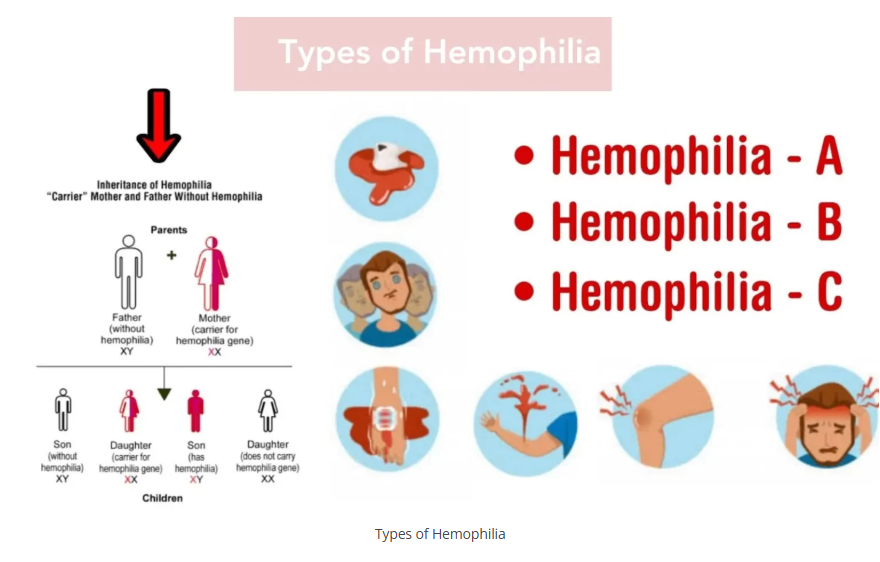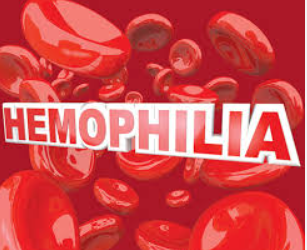Hemophilia is a genetic disorder that affects the blood’s ability to clot properly. People with hemophilia bleed longer after injuries and may experience spontaneous bleeding, especially into joints and muscles.

The Types of Hemophilia:
1. Hemophilia A
- Deficient clotting factor: Factor VIII
- Prevalence: Most common type (~80–85% of cases)
- Inheritance: X-linked recessive (mostly affects males)
- Symptoms: Prolonged bleeding, spontaneous joint and muscle bleeding, easy bruising
- Treatment: Factor VIII replacement therapy; desmopressin (for mild cases)
2. Hemophilia B (Christmas Disease)
- Deficient clotting factor: Factor IX
- Prevalence: Less common than Hemophilia A
- Inheritance: X-linked recessive
- Symptoms: Similar to Hemophilia A, may also cause joint and muscle bleeding
- Treatment: Factor IX replacement therapy
3. Hemophilia C
- Deficient clotting factor: Factor XI
- Prevalence: Rare, more common in certain populations (e.g., Ashkenazi Jews)
- Inheritance: Autosomal recessive (affects both males and females)
- Symptoms: Usually milder bleeding; often occurs after surgery or trauma
- Treatment: Factor XI replacement or antifibrinolytic drugs

The cause of hemophilia:
1. Genetic Causes
- Mutation in clotting factor genes:
- Hemophilia A: Mutation in the F8 gene → deficiency of factor VIII
- Hemophilia B: Mutation in the F9 gene → deficiency of factor IX
- Hemophilia C: Mutation in the F11 gene → deficiency of factor XI
- Inheritance pattern:
- Hemophilia A & B:X-linked recessive
- Males (XY) with the defective gene will have hemophilia.
- Females (XX) with one defective gene are usually carriers but usually do not show severe symptoms.
- Hemophilia C:Autosomal recessive
- Both males and females can be affected if they inherit two defective copies.
- Hemophilia A & B:X-linked recessive
- Spontaneous mutations:
- Sometimes, hemophilia occurs without family history due to a new mutation in the gene.
2. Non-genetic Causes
- Extremely rare; hemophilia is almost always genetic.
- Acquired hemophilia (very rare):
- The body develops antibodies against clotting factors (usually in adults).
- Can be triggered by autoimmune disorders, pregnancy, or certain medications.
The symptoms of hemophilia
1. Excessive Bleeding
- Prolonged bleeding from cuts, injuries, or after surgery/dental procedures.
- Frequent nosebleeds (epistaxis) that are hard to stop.
- Easy bruising even after minor bumps or injuries.
2. Internal Bleeding
- Joint bleeding (hemarthrosis): Swelling, pain, warmth, and stiffness in joints, especially knees, elbows, and ankles. Chronic bleeding can lead to joint damage.
- Muscle bleeds: Pain, swelling, and tightness in muscles.
- Internal organ bleeding: Can be life-threatening if it occurs in the brain or gastrointestinal tract.
3. Other Signs
- Blood in urine or stool in severe cases.
- Unexpected bleeding after minor injuries or even spontaneously (in severe hemophilia).
- Prolonged bleeding after vaccinations or injections.
Severity:
- Mild hemophilia: Bleeding usually occurs after surgery or serious injury.
- Moderate hemophilia: Bleeding after minor injuries.
- Severe hemophilia: Spontaneous bleeding occurs, often in joints or muscles, without obvious cause.
The treatment of hemophilia:
1. Replacement Therapy (Clotting Factor Concentrates)
- Purpose: To replace the missing clotting factor (Factor VIII for hemophilia A, Factor IX for hemophilia B).
- Methods:
- Intravenous (IV) infusions of clotting factor concentrates.
- Can be on-demand (when bleeding occurs) or prophylactic (regularly to prevent bleeding).
- Types of factor concentrates:
- Plasma-derived: From donated human plasma.
- Recombinant: Lab-made, lower risk of infections.
2. Desmopressin (DDAVP)
- Used for: Mild hemophilia A.
- How it works: Stimulates the body to release stored Factor VIII, temporarily raising clotting ability.
- Administration: Injection or nasal spray.
3. Antifibrinolytic Medications
- Examples: Tranexamic acid, aminocaproic acid.
- Purpose: Help prevent clots from breaking down too quickly, useful for mouth or dental bleeding.
4. Gene Therapy (Emerging)
- Goal: Introduce functional copies of the defective gene to produce clotting factor naturally.
- Status: Available in clinical trials and some approved cases, mostly for severe hemophilia B.
5. Supportive Care
- Physical therapy: Prevents joint damage from repeated bleeding.
- Pain management: Careful use of medications, avoiding drugs that worsen bleeding (like aspirin).
- Prompt treatment of injuries: Even minor injuries should be addressed quickly.
6. Lifestyle Considerations
- Avoid contact sports or activities with high risk of injury.
- Maintain a healthy weight to reduce joint stress.
- Vaccinations should be given carefully (using small needles and applying pressure to prevent bleeding).

